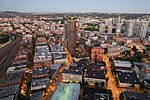St. Lawrence (restaurant)

St. Lawrence is a French-Canadian restaurant in the Japantown neighbourhood of Vancouver, British Columbia. It opened in June 2017. Located on the ground floor of a heritage building at 269 Powell St, originally a Japanese general store, St. Lawrence serves a blend of traditional Québécois dishes and French haute cuisine. Executive chef and owner J.C. Poirier began developing the concept for St. Lawrence in 2013, and sought with both the menu and the décor to replicate the feeling of being inside a rural French home and eating a country-style meal. The interior, which features a blue and green colour scheme and numerous keepsakes and photographs, was developed by Vancouver-based studio Ste. Marie. The menu at St. Lawrence is primarily concentrated on rich, hearty fare served in large portions, running counter to the predominant stereotype of Vancouver cuisine as light and health-focused. Lesser-known dishes and uncommon cuts of meat like sweetbreads are featured in order to showcase Quebecois cuisine beyond its most famous dish, poutine. The plating style is deliberately basic, and presentation of many dishes incorporates playful touches inspired by the culture of Quebec, such as the tourtière, served with a miniature flag of the Montreal Canadiens hockey team, a Quebecois cultural icon. St. Lawrence has been a critical success since it opened. It has been highly-ranked on several Canadian "best restaurant" lists, and was awarded one Michelin star in 2022. It has ranked on the Canada's 100 Best list since its first eligible year, and in 2020 it was ranked the second-best restaurant in Canada. Critics have highlighted the richness of the dishes, which many noted felt like "comfort food", as well as the rustic interior design. Some critics noted that the high menu prices came at an apparent contrast to the rustic aesthetic.
Excerpt from the Wikipedia article St. Lawrence (restaurant) (License: CC BY-SA 3.0, Authors, Images).St. Lawrence (restaurant)
Powell Street, Vancouver Strathcona
Geographical coordinates (GPS) Address Nearby Places Show on map
Geographical coordinates (GPS)
| Latitude | Longitude |
|---|---|
| N 49.2833 ° | E -123.098 ° |
Address
Powell Street 259
V6A Vancouver, Strathcona
British Columbia, Canada
Open on Google Maps










